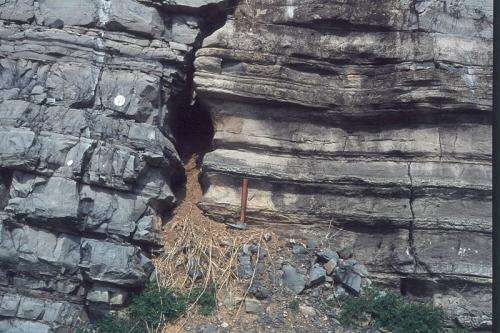December 17, 2013 report
Rock weathering may have led to 'Snowball Earth'

(Phys.org) —A team of researchers conducting a field study in the Mackenzie Mountains in northwest Canada is suggesting rock weathering almost a billion years ago, may have led to the entire planet being encased in ice for 55 million years. In their paper published in Proceedings of the National Academy of Sciences, the multi-national team describes their field study and subsequent analysis of rock samples they retrieved and how doing so led to what they believe is an explanation of one of the most dramatic instances of climate change on record.
Scientists believe that the Earth has experienced many episodes of global glaciation—where the entire planet is covered in ice, resulting in what is loosely termed, a "Snowball Earth." To better understand climate change heading into the future, scientists look to the past. In this latest effort, the research team looked at an event known as the Sturtian glaciation—after a billion years with no ice on the planet at all, suddenly, the Earth was covered with the stuff for 55 million years. Until now, why this happened has been a mystery.
To find out more, the team traveled to the Mackenzie Mountains—a part of the planet that has been found to be useful for plotting the past due to its glacial history. The researchers collected sedimentary rocks left by glacial movement along with rock samples found above and below them.
The rock samples were all taken back to the lab where the researchers tested them for osmium and rhenium levels—the latter breaks down to the former over time, offering a way to determine the age of the rocks. Using this technique, the researchers were able to conclude that the Sturtian lasted for approximately 55 million years. The team also tested the rock samples for isotopes of the same two elements and that led to the discovery that carbon dioxide had been sequestered in them. This led to the development of a theory that suggests that volcanic activity prior to the Sturtian also led to the absorption of so much carbon dioxide (weathering opens up rock causing it to be more absorbent) from the atmosphere that the planet cooled until it eventually became a Snowball Earth.
Moving forward, the question of whether the Sturtian was truly one long event, or if it was actually a time of many glacial increases and retreats will be further studied to better understand the mechanism behind such global extremes.
More information: Re-Os geochronology and coupled Os-Sr isotope constraints on the Sturtian snowball Earth, PNAS, Published online before print December 16, 2013, DOI: 10.1073/pnas.1317266110
Abstract
After nearly a billion years with no evidence for glaciation, ice advanced to equatorial latitudes at least twice between 717 and 635 Mya. Although the initiation mechanism of these Neoproterozoic Snowball Earth events has remained a mystery, the broad synchronicity of rifting of the supercontinent Rodinia, the emplacement of large igneous provinces at low latitude, and the onset of the Sturtian glaciation has suggested a tectonic forcing. We present unique Re-Os geochronology and high-resolution Os and Sr isotope profiles bracketing Sturtian-age glacial deposits of the Rapitan Group in northwest Canada. Coupled with existing U-Pb dates, the postglacial Re-Os date of 662.4 ± 3.9 Mya represents direct geochronological constraints for both the onset and demise of a Cryogenian glaciation from the same continental margin and suggests a 55-My duration of the Sturtian glacial epoch. The Os and Sr isotope data allow us to assess the relative weathering input of old radiogenic crust and more juvenile, mantle-derived substrate. The preglacial isotopic signals are consistent with an enhanced contribution of juvenile material to the oceans and glacial initiation through enhanced global weatherability. In contrast, postglacial strata feature radiogenic Os and Sr isotope compositions indicative of extensive glacial scouring of the continents and intense silicate weathering in a post–Snowball Earth hothouse.
Journal information: Proceedings of the National Academy of Sciences
© 2013 Phys.org


















